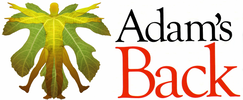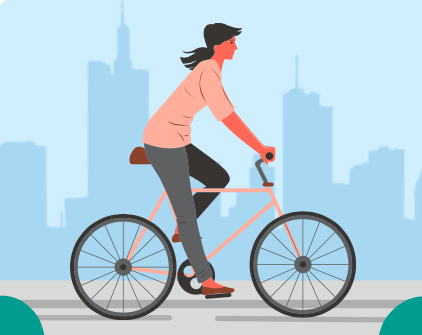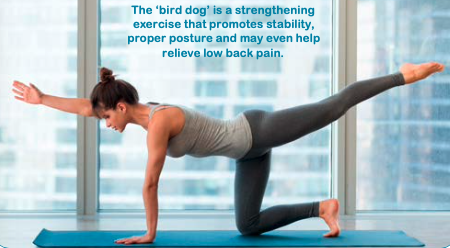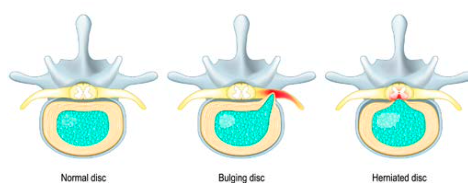|
8/3/2023 0 Comments Healthy Banana PancakesThese delicious pancakes are always popular − dress them up with your favourite toppings for a special breakfast or dessert.Makes 6 pancakes
Ingredients
Method
Topping Ideas
0 Comments
Do you love to hit the trails and pedal yourself towards wellness? Cycling is a great way to build muscle tone and improve your fitness. It’s also a wonderful form of low-impact, cost-effective transport.But, as with any type of exercise, cycling can cause damage or pain. So, what are the health benefits, what injuries can occur, and how can you limit the risks? Let’s take a look...
Health benefits Research shows that cardiorespiratory fitness is improved by regular cycling. Your heart and lungs function better and your risk of cardiovascular disease (such as stroke, high blood pressure and heart attack) is lowered. Cycling uses several muscle groups and builds strength and stamina. It also helps with balance and coordination − which may help to prevent falls and fractures. But cycling has broader benefits than just physical. Frequent cycling lowers your risk of stress and is great for your mood. Cycling may even improve your self-esteem, helping you to feel more confident about your ability to achieve goals and live the life you want. That’s powerful! Cycling injuries What about the flip side? Because riding a bike involves your entire body, a range of injuries is possible. Common cycling issues include those to the back, knees, wrists, and hands. Problems can occur for a range of reasons: overuse − remaining in one position for an extended period of time, muscle strain and imbalances, and falls. Injury prevention Given the benefits of cycling, how can you prevent injury? Start with a well set-up bike. Specialised equipment − like a quality helmet, suitable shoes, and a padded seat and gloves − can reduce strain and injury risk. If you’re unsure how to set yourself up correctly, find a bike shop or riding group who can help. Posture is important. Ride with your elbows slightly bent, keep your hands on the handlebars, and alternate their position regularly. Make sure your seat and pedals are in the right position to allow your back, hips, knees, ankles, and feet to work efficiently and without strain. Try a wider, padded seat if you experience saddle numbness or pain. Stretch often. Make sure your back and core function well. If your spine doesn’t move correctly, or your muscular midsection is weak, your back will bear the brunt. Both of these problems can contribute to spinal stress and overuse- related low back pain. Cycling is a wonderful form of exercise. When you combine the right set-up and posture with optimal spine and core function, your health and happiness will bloom. If you have questions, ask. We’re here to help. You've probably been told that sit-ups are great for your core, but is this advice actually correct? What do sit-ups achieve, and are they the best exercise for your body? If not, what alternatives are there?What is the core and why strengthen it?
The core refers to your body’s muscular mid-section. You can think of it like a square house. The front wall includes your abdominal muscles; the roof is your diaphragm. The floor includes your pelvic floor and hip muscles, and the back wall is formed by muscles that cross your spine and bottom. Your core enables spinal stability and forms a foundation during movement − which supports your spine, arms and legs during motion.Your core also helps move your trunk, improve balance, and even enhance breathing. A strong core can reduce your risk of injury and back pain. Sit-ups work the front wall and the hip flexors, but they are not the most effective or safest option. They can cause harm in people who have a weak core, or previous injuries. During a sit-up your spine is repeatedly put under force in a bent position, which can cause low back discomfort. What are better core exercise options? There are safer, more targeted exercises. To begin gently, lie on your back, bend your knees and place your feet on the floor. Tighten your tummy muscles to flatten the curve of your spine against the floor. Hold for 10 seconds. Relax. Repeat three times. Simple and safe! The ‘bird dog’ uses your whole body to strengthen your core, hips, and back muscles. Place your hands and knees on the ground, shoulder and hip width apart. Tighten your core, keep your spine neutral. Extend one arm in front of you and the opposite leg out, keeping your hips and shoulders level and parallel to the floor. Hold for a few seconds. Return to the starting position. Complete five reps on each side. Done! There are many simple, effective exercises to suit all levels of fitness. To choose the right exercises to strengthen your core, speak to us. We can provide effective, safe options that are tailored to your current health situation and needs. Melatonin has become a popular topic as awareness increases about the importance of sleep for our health and wellbeing. But what is it and should we worry about it?What is melatonin?
Melatonin is a hormone – a chemical naturally produced in your body – which helps to control your cycle of sleep and wakefulness. It’s made in the pineal gland in your brain, and is one of the things that can help you get a good night’s sleep. Your melatonin production is closely linked to light, so it rises at night and falls during the day. Can you improve your levels naturally? Yes! Melatonin production is affected by your lifestyle, so you do have control over some of the factors which manage melatonin levels. Practising good sleep hygiene is the healthiest way to improve night-time melatonin levels. This simply means having a bedroom environment and daily routines and habits that help you sleep well. Stick to regular times for bedtime and waking, and make your bedroom comfortable, without clutter or distracting devices. Bright lights (like those from electronic devices) late in the evening are particularly bad for affecting sleep. Caffeine, alcohol, and nicotine can disrupt your melatonin production. Things that seriously disrupt sleeping patterns, like jetlag or working night shifts, can affect your melatonin levels. The impact of them can be reduced by following good sleep practices as much as possible. Spending time outdoors in natural daylight strengthens your brain’s connection to night and day and supports melatonin production. If you’re practising good sleep habits but still having problems with sleep, talk to us. There can be a variety of reasons, from lifestyle issues to pain or posture. We can help identify possible causes, and where appropriate offer advice and treatment. You’ve probably heard of a slipped disc. It’s a common spinal injury which can cause severe pain. But what does this term really mean?You might think of a ‘slipped disc’ as a disc dislodging, or slipping out from your spine. This isn’t what happens. To know what actually takes place, it’s helps to understand some basic spinal anatomy. Let’s take a look...
There’s a disc between each vertebra in your spine − a bit like a rubbery cushion. The spinal disc has a soft inner core or jelly-like centre that’s surrounded by strong cartilage. When we talk about a slipped disc, we mean that the ‘jelly’ has pushed or protruded through the cartilage, forming a bulge or herniation on the outside of the disc. So the more accurate term is a disc herniation − nothing slips. A herniated disc can press on a nearby spinal nerve. Just as standing on a garden hose blocks the flow of water, pressure on nerve tissue changes the flow of messages that travel along this nerve. This is why pain is not always felt at the injury site. A disc herniation in your neck may affect an arm and a disc herniation in your low back may affect a leg. The involved limb might experience burning, stinging, or electrical pain, weakness or numbness. How to prevent a herniated disc As always, prevention is the best cure. To limit your risk of experiencing a herniated disc, quit (or never start) smoking. Smoking damages the discs, just as it damages other tissues. If you have diabetes, manage it carefully. If you carry extra weight, especially excessive tummy fat, aim to whittle it down to healthy levels. Exercise regularly, keep flexible and strengthen your core; yoga, cycling, swimming, and walking all help maintain good core strength and flexibility. To find some simple core strengthening exercises, see our article about the core and sit-ups. It’s also very important to maintain correct posture when carrying out daily tasks, especially lifting. Can a herniated disc be treated? A herniated disc may resolve on its own, this is called spontaneous resorption. Recovery can be supported with conservative, non-surgical management. Ice, heat, and analgesics may also help. Speak to us if you have any questions about disc herniations. We’re happy to provide answers and advice. We will ensure you receive our best care, designed to improve your wellbeing. But to make the most of your adjustments and treatment there are some simple steps you can take once you leave our practice.1 Take a gentle walk
Walking creates motion through the limbs, pelvis, and spine and may settle your spine and nervous system. It increases blood flow around your body and to your brain, and can elevate mood and soothe stress. 2 Relax Stress is known to affect your nervous system in a variety of ways, so find ways to keep calm after an adjustment. You might read a book, take a bath or shower, cook, or just cuddle your family or pet. Combine mindfulness with your short walk. Enjoy a nap or meditate. Focus on your breath: inhale deeply, exhale slowly, and repeat as often as you can. 3 Be aware of your posture Sleep correctly on your back or side, never on your stomach. Stand and sit properly; your ears should rest above your shoulders. Hold your belly in and support the curves of your spine when seated. Bend with your knees, not your back. Aim to keep your spinal curves in a neutral position − great posture will support your spine and your care. 4 Drink a glass or two of water Every cell in your body needs water to function; in fact, your nervous system couldn’t work without H20. Yet, dehydration is common, according to research published in the journal, Nutrients, 82% of Australians fail to consume enough water. Support your body post-adjustment by drinking plenty of water. 5 Be gentle to your mind and body Allow yourself time to integrate your adjustments. Don’t schedule a workout or a long run, a karate lesson or a demanding physical event after your chiropractic appointment. Where possible, avoid experiences that will sap your brainpower, like a serious meeting. Try to just be present in your body and mind without significant physical or psychological stress. 6 Pay close attention Many changes occur in your body after a chiropractic adjustment; some subtle, some not. Does your breathing change; do your muscles feel more relaxed, has your posture improved? Does your mood feel different and your mind feel clearer? Notice what occurs soon after your adjustments and in the following days. The body ‘talks’ and this feedback provides you − and us − with useful information. Remember, though, the advice in this article is general in nature. What you need may differ from the supposed ‘norm’. So, ask us about suitable steps and let us know about any post-care events you have planned. Got another form of treatment booked? Sometimes another step might sound helpful, but could hinder your progress. At Adam's Back we want you to get the most from your care. Let us know if you have any questions, we’re happy to answer them for you. |
AuthorAdam's Back is a team of dedicated complimentary health professionals. Our aim is to support you in finding drug-free solutions for better health. Archives
July 2024
Categories |
Search by typing & pressing enter






 RSS Feed
RSS Feed